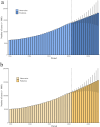Global, regional, and national burden of benign prostatic hyperplasia from 1990 to 2021 and projection to 2035
- PMID: 39972318
- PMCID: PMC11837592
- DOI: 10.1186/s12894-025-01715-9
Global, regional, and national burden of benign prostatic hyperplasia from 1990 to 2021 and projection to 2035
Abstract
Background: Benign prostatic hyperplasia (BPH) is a common male urological disease around the world. This study aimed to evaluate global, regional, and national burden of BPH from 1990 to 2021, and to forecast the incidence and prevalence of BPH to 2035.
Methods: Using the data and methods of the Global Burden of Disease 2021, we presented the incidence, prevalence, and disability-adjusted life-years (DALYs) of BPH from 1990 to 2021. The trends of burden over time were assessed using estimated annual percentage changes. We applied Bayesian age-period-cohort model to forecast the incidence and prevalence of BPH to 2035.
Results: In 2021, the global number of incident cases, prevalent cases, and DALYs of BPH were 137.88, 1125.02, and 22.36 per 100,000 populations, respectively. From 1990 to 2021, the age-standardized incidence rate (ASIR), age-standardized prevalence rate (ASPR), and age-standardized DALYs rate (ASDR) of BPH remained stable. The highest ASIR, ASPR, and ASDR were recorded in Eastern Europe in 2021. Nationally, China had the highest number of incident cases, prevalent cases, and DALYs of BPH. With the increase of socio-demographic index, the trends of ASIR, ASPR, and ASDR all exhibit an initial rise followed by a gradual decline. The global incidence and prevalence are expected to increase from 962.42 to 7878.68 per 100,000 populations in 2022 to 998.55 and 8620.60 per 100,000 populations in 2035, respectively.
Conclusions: The persistent burden of BPH continues to pose a critical public health challenge. The escalating prevalence among middle-aged and elderly populations underscores the imperative to tackle this widespread condition.
Keywords: Benign prostatic hyperplasia; Burden of disease; Disability-adjusted life-years; Incidence; Prevalence.
© 2025. The Author(s).
Conflict of interest statement
Declarations. Ethics approval and consent to participate: Not applicable. Consent for publication: Not applicable. Clinical trial number: Not applicable. Competing interests: The authors declare no competing interests.
Figures



Similar articles
-
Global burden of benign prostatic hyperplasia in males aged 60-90 years from 1990 to 2019: results from the global burden of disease study 2019.BMC Urol. 2024 Sep 5;24(1):193. doi: 10.1186/s12894-024-01582-w. BMC Urol. 2024. PMID: 39237966 Free PMC article.
-
Comparison of trend analysis of varicella zoster disease burden between China and the world 1990-2021 and disease burden forecast 2030.Front Public Health. 2025 Mar 10;13:1535977. doi: 10.3389/fpubh.2025.1535977. eCollection 2025. Front Public Health. 2025. PMID: 40129585 Free PMC article.
-
Burden of uterine cancer in China from 1990 to 2021 and 15-year projection: a systematic analysis and comparison with global levels.Reprod Health. 2024 Oct 10;21(1):144. doi: 10.1186/s12978-024-01882-2. Reprod Health. 2024. PMID: 39390595 Free PMC article.
-
Global and China trends and forecasts of disease burden for female lung Cancer from 1990 to 2021: a study based on the global burden of disease 2021 database.J Cancer Res Clin Oncol. 2025 Feb 8;151(2):68. doi: 10.1007/s00432-025-06084-2. J Cancer Res Clin Oncol. 2025. PMID: 39921760 Free PMC article. Review.
-
Evolving landscape of colorectal cancer: Global and regional burden, risk factor dynamics, and future scenarios (the Global Burden of Disease 1990-2050).Ageing Res Rev. 2025 Feb;104:102666. doi: 10.1016/j.arr.2025.102666. Epub 2025 Jan 18. Ageing Res Rev. 2025. PMID: 39828028 Review.
Cited by
-
Genetic Modulation of Silodosin Exposure and Efficacy: The Role of CYP3A4, CYP3A5, and UGT2B7 Polymorphisms in Benign Prostatic Hyperplasia Management.J Pers Med. 2025 Aug 18;15(8):386. doi: 10.3390/jpm15080386. J Pers Med. 2025. PMID: 40863448 Free PMC article.
-
Crosstalk between mitochondrial dysfunction and benign prostatic hyperplasia: unraveling the intrinsic mechanisms.Can J Urol. 2025 Aug 29;32(4):255-269. doi: 10.32604/cju.2025.066523. Can J Urol. 2025. PMID: 40910323 Review.
-
Impact of laser power settings on sexual and urinary outcomes in holmium laser enucleation of the prostate: a multicenter randomized controlled trial.Lasers Med Sci. 2025 Jun 24;40(1):297. doi: 10.1007/s10103-025-04551-3. Lasers Med Sci. 2025. PMID: 40553165 No abstract available.
References
-
- Chughtai B, Forde JC, Thomas DD, Laor L, Hossack T, Woo HH, et al. Benign prostatic hyperplasia. Nat Reviews Disease Primers. 2016;2:16031. - PubMed
-
- Sandhu JS, Bixler BR, Dahm P, Goueli R, Kirkby E, Stoffel JT, et al. Management of lower urinary tract symptoms attributed to Benign Prostatic Hyperplasia (BPH): AUA Guideline Amendment 2023. J Urol. 2024;211(1):11–9. - PubMed
-
- Egan KB. The Epidemiology of Benign Prostatic Hyperplasia Associated with lower urinary tract symptoms: Prevalence and Incident Rates. Urologic Clin North Am. 2016;43(3):289–97. - PubMed
-
- Speakman M, Kirby R, Doyle S, Ioannou C. Burden of male lower urinary tract symptoms (LUTS) suggestive of benign prostatic hyperplasia (BPH) - focus on the UK. BJU Int. 2015;115(4):508–19. - PubMed
-
- Welch G, Weinger K, Barry MJ. Quality-of-life impact of lower urinary tract symptom severity: results from the Health professionals follow-up study. Urology. 2002;59(2):245–50. - PubMed
MeSH terms
LinkOut - more resources
Full Text Sources
Medical

